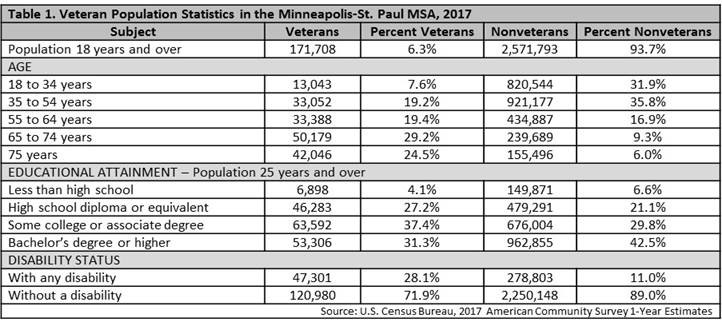 The Minneapolis-St. Paul metropolitan area is a national leader in finance, advanced manufacturing, agriculture and retailing.
The Minneapolis-St. Paul metropolitan area is a national leader in finance, advanced manufacturing, agriculture and retailing.
Medical devices, electronics and processed foods are strong suits recognized globally.
Want the freshest data delivered by email? Subscribe to our regional newsletters.
10/31/2018 3:00:00 PM
Tim O'Neill
On Monday, Nov. 12, Veterans Day will be observed by Americans throughout the United States to celebrate the service of all U.S. military veterans. As an appreciation to those who have served or are currently serving, this month’s Local Look blog post will focus on veterans in the Twin Cities region.
As of 2017, there were about 2,743,500 Minnesotans 18 years of age and older living in the Minneapolis-St. Paul Metropolitan Statistical Area (MSA). Just over six percent of that population, or 171,700 people, were veterans (Table 1).

Recent data from the American Community Survey (ACS) show a number of stark differences for the veteran community in the Minneapolis-St. Paul MSA when compared to the nonveteran population. For one, veterans are much more likely to be older. As of 2017, over half (53.7%) of veterans reported being 65 years of age and older. Of the nonveteran population over the age of 18, only 15.3 percent reported being 65 years of age and older.
Another major difference: Veterans are much less likely to have a bachelor’s degree or more than their nonveteran counterparts. More specifically, 31.3 percent of veterans report having a bachelor’s degree or more, compared with 42.5 percent of nonveterans. This data backs up the fact that serving in the military may delay or stop veterans from seeking a four-year degree or more. Interestingly, however, a higher share of veterans in the region have a high school diploma or more (95.9%) than the nonveteran population (93.4%). Here is an interactive visualization of educational attainment for veterans.
Lastly, ACS data reveal that veterans in the Minneapolis-St. Paul MSA are much more likely to have a disability than the nonveteran population. As of 2017, just over 28 percent of veterans reported having any disability, compared with 11 percent of the nonveteran population. Along with reported disabilities, many veterans may also live with mental and behavioral health challenges, have difficulty finding employment, have financial hurdles, or other issues. Minnesota Service CORE and the Minnesota Department of Veterans Affairs (MDVA) just celebrated 10 years of a unique partnership that is designed to help out veterans with these challenges.
The Minnesota Department of Employment and Economic Development (DEED) has specific employment services for veterans, with the goal of connecting employers searching for quality candidates and veterans searching for life-sustaining career opportunities. Check out more resources.
Whether you’re a more seasoned or younger veteran, have a high school diploma or higher education, or have a disability, there is a place in Minnesota’s labor market for you. Check out the many resources for assisting veterans with finding the right career online:
Contact Tim O’Neill at 651-259-7401.